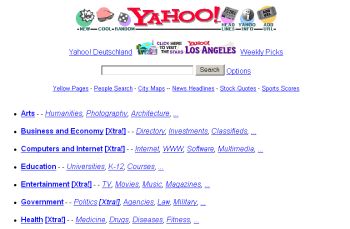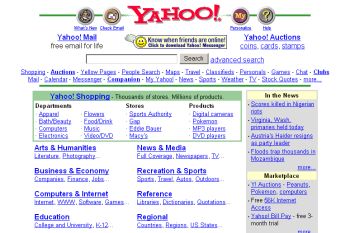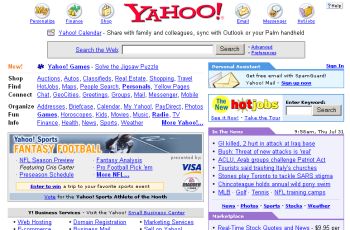Friday, August 1, 2003
Salon on Google, Again
Today, Salon.com’s giving a good and short overview on Google past, present and future.
Illustrated Chronicles of the Portal Plague
The Past
The end of the 20th century saw a high portality rate (previously covered by the Wayback Machine). Portals, as you may know, are the most deadly plague of the global web. The symptoms are easily spotted. Please see figure 1 below: this is a healthy site. Young, strong, energetic, yet humble and serving.

Fig. 1: A Healthy Site
As time goes by, our patient grows older. The phenomenon of featuritis has set in, which can be seen from a multitude of new, unrelated blue spots. Most of these web links are not in a healthy status. They can make a site slow, phlegmatic, dragging itself through the day. The servant is infected and has become partly self-serving, partly annoying. Yet, not all is lost (see figure 2).

Fig. 2: First Signs of Featuritis
If the link virus spreads so much, the actual portal plague sets in. Every area within this preportal stage site will now be in fierce battle for the client’s attention and taking out the weapon of over-emphasis (common symptoms are animation, blinking, changes in color and size). The page will become bloated and is unable to move along on certain days. It’s one of the last chances for a usability doctor to help. See figure 3 below:

Fig. 3: The Attention Virus Set In
The patient is screaming for help now. Others who may be getting around more on the web might have gotten used to it, but the final stage of the portal plague is shocking when seen by some for the first time. The patient babbles in feverish dreams (“Click me! Love me! Heal me!”), unsure of what he wants to communicate, but needy of attention. It is best to leave a site on its own for a while. This plague can be healed, but it is also very deadly at this final stage. At the moment, the patient (see figure 4 below) is getting intravenous injection from a healthy site (Google):

Fig. 4: The Final Portal Stage
The Present and Future
Many sites are dying today, and they don’t yet notice. Sites like Lycos, while still happily wagging their tail, are already long dead — long in dog years — yet the stench of their heritage can still be noticed in some dark alleys of the web. Other sites healed. AltaVista is one of them, though its fate still unclear. And some have the luxury of getting away with it because they are unique in what they have to offer, or at least, uniquely branded. Big grinning babies face us in giant Flash advertisements when we go to Amazon, asking us to give money in return for toys, and yet we come back for more books.
But for most
of the online networks, they path of survival in the 21st century is clear and ahead; be like Google. Simple, unobtrusive,
serving and humble. Then give the very best you have to be a part of net society. (You might make a good buck out of it, too.)
And shower three times a day, because cleanliness is the number-one enemy of portality; that last century
sickness that sped up the end of the Dark Ages of the Web, and led us into our current early stages of the
Renaissance.
>> More posts
Advertisement
This site unofficially covers Google™ and more with some rights reserved. Join our forum!
